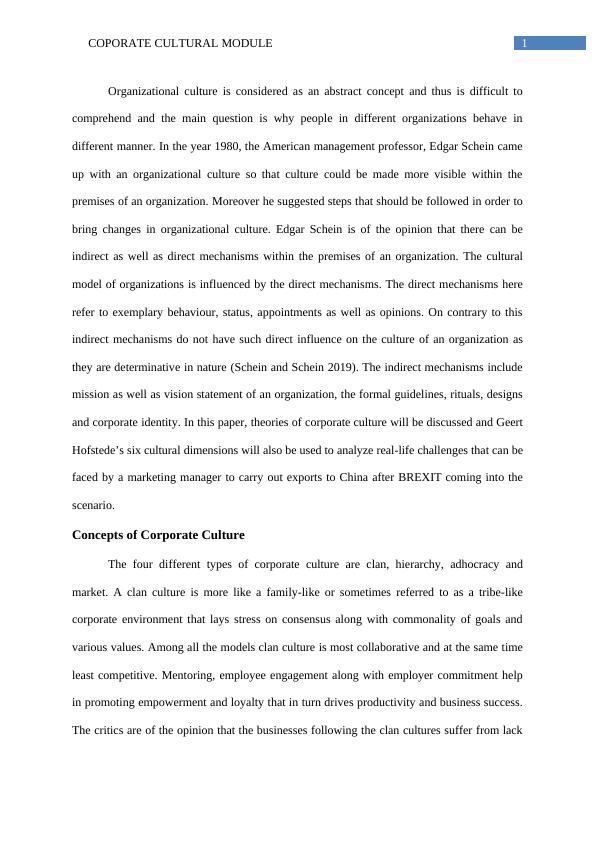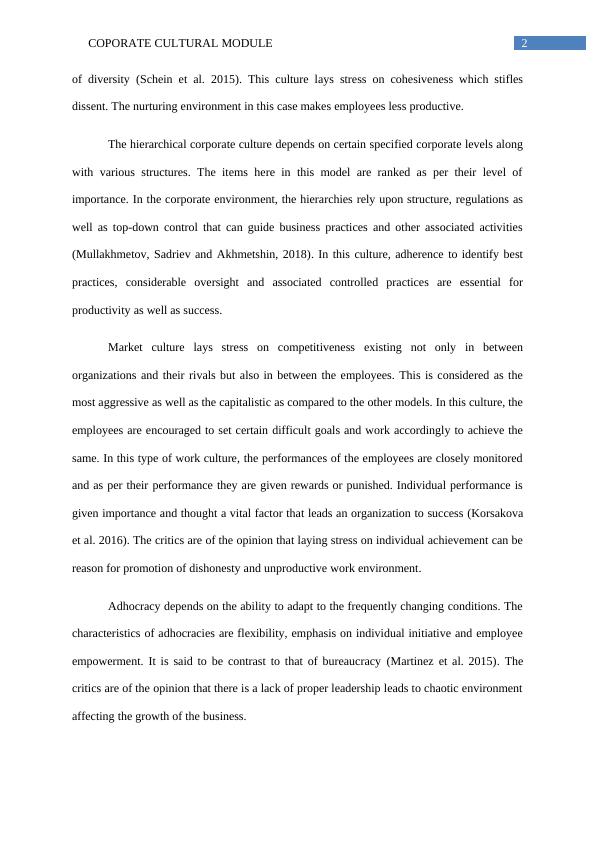Corporate Cultural Module | Concept
9 Pages2375 Words25 Views
Added on 2022-08-22
Corporate Cultural Module | Concept
Added on 2022-08-22
ShareRelated Documents
Running head: CORPORATE CULTURAL MODULE
CORPORATE CULTURAL MODULE
Name of the Student
Name of the university
Author note
CORPORATE CULTURAL MODULE
Name of the Student
Name of the university
Author note

1COPORATE CULTURAL MODULE
Organizational culture is considered as an abstract concept and thus is difficult to
comprehend and the main question is why people in different organizations behave in
different manner. In the year 1980, the American management professor, Edgar Schein came
up with an organizational culture so that culture could be made more visible within the
premises of an organization. Moreover he suggested steps that should be followed in order to
bring changes in organizational culture. Edgar Schein is of the opinion that there can be
indirect as well as direct mechanisms within the premises of an organization. The cultural
model of organizations is influenced by the direct mechanisms. The direct mechanisms here
refer to exemplary behaviour, status, appointments as well as opinions. On contrary to this
indirect mechanisms do not have such direct influence on the culture of an organization as
they are determinative in nature (Schein and Schein 2019). The indirect mechanisms include
mission as well as vision statement of an organization, the formal guidelines, rituals, designs
and corporate identity. In this paper, theories of corporate culture will be discussed and Geert
Hofstede’s six cultural dimensions will also be used to analyze real-life challenges that can be
faced by a marketing manager to carry out exports to China after BREXIT coming into the
scenario.
Concepts of Corporate Culture
The four different types of corporate culture are clan, hierarchy, adhocracy and
market. A clan culture is more like a family-like or sometimes referred to as a tribe-like
corporate environment that lays stress on consensus along with commonality of goals and
various values. Among all the models clan culture is most collaborative and at the same time
least competitive. Mentoring, employee engagement along with employer commitment help
in promoting empowerment and loyalty that in turn drives productivity and business success.
The critics are of the opinion that the businesses following the clan cultures suffer from lack
Organizational culture is considered as an abstract concept and thus is difficult to
comprehend and the main question is why people in different organizations behave in
different manner. In the year 1980, the American management professor, Edgar Schein came
up with an organizational culture so that culture could be made more visible within the
premises of an organization. Moreover he suggested steps that should be followed in order to
bring changes in organizational culture. Edgar Schein is of the opinion that there can be
indirect as well as direct mechanisms within the premises of an organization. The cultural
model of organizations is influenced by the direct mechanisms. The direct mechanisms here
refer to exemplary behaviour, status, appointments as well as opinions. On contrary to this
indirect mechanisms do not have such direct influence on the culture of an organization as
they are determinative in nature (Schein and Schein 2019). The indirect mechanisms include
mission as well as vision statement of an organization, the formal guidelines, rituals, designs
and corporate identity. In this paper, theories of corporate culture will be discussed and Geert
Hofstede’s six cultural dimensions will also be used to analyze real-life challenges that can be
faced by a marketing manager to carry out exports to China after BREXIT coming into the
scenario.
Concepts of Corporate Culture
The four different types of corporate culture are clan, hierarchy, adhocracy and
market. A clan culture is more like a family-like or sometimes referred to as a tribe-like
corporate environment that lays stress on consensus along with commonality of goals and
various values. Among all the models clan culture is most collaborative and at the same time
least competitive. Mentoring, employee engagement along with employer commitment help
in promoting empowerment and loyalty that in turn drives productivity and business success.
The critics are of the opinion that the businesses following the clan cultures suffer from lack

2COPORATE CULTURAL MODULE
of diversity (Schein et al. 2015). This culture lays stress on cohesiveness which stifles
dissent. The nurturing environment in this case makes employees less productive.
The hierarchical corporate culture depends on certain specified corporate levels along
with various structures. The items here in this model are ranked as per their level of
importance. In the corporate environment, the hierarchies rely upon structure, regulations as
well as top-down control that can guide business practices and other associated activities
(Mullakhmetov, Sadriev and Akhmetshin, 2018). In this culture, adherence to identify best
practices, considerable oversight and associated controlled practices are essential for
productivity as well as success.
Market culture lays stress on competitiveness existing not only in between
organizations and their rivals but also in between the employees. This is considered as the
most aggressive as well as the capitalistic as compared to the other models. In this culture, the
employees are encouraged to set certain difficult goals and work accordingly to achieve the
same. In this type of work culture, the performances of the employees are closely monitored
and as per their performance they are given rewards or punished. Individual performance is
given importance and thought a vital factor that leads an organization to success (Korsakova
et al. 2016). The critics are of the opinion that laying stress on individual achievement can be
reason for promotion of dishonesty and unproductive work environment.
Adhocracy depends on the ability to adapt to the frequently changing conditions. The
characteristics of adhocracies are flexibility, emphasis on individual initiative and employee
empowerment. It is said to be contrast to that of bureaucracy (Martinez et al. 2015). The
critics are of the opinion that there is a lack of proper leadership leads to chaotic environment
affecting the growth of the business.
of diversity (Schein et al. 2015). This culture lays stress on cohesiveness which stifles
dissent. The nurturing environment in this case makes employees less productive.
The hierarchical corporate culture depends on certain specified corporate levels along
with various structures. The items here in this model are ranked as per their level of
importance. In the corporate environment, the hierarchies rely upon structure, regulations as
well as top-down control that can guide business practices and other associated activities
(Mullakhmetov, Sadriev and Akhmetshin, 2018). In this culture, adherence to identify best
practices, considerable oversight and associated controlled practices are essential for
productivity as well as success.
Market culture lays stress on competitiveness existing not only in between
organizations and their rivals but also in between the employees. This is considered as the
most aggressive as well as the capitalistic as compared to the other models. In this culture, the
employees are encouraged to set certain difficult goals and work accordingly to achieve the
same. In this type of work culture, the performances of the employees are closely monitored
and as per their performance they are given rewards or punished. Individual performance is
given importance and thought a vital factor that leads an organization to success (Korsakova
et al. 2016). The critics are of the opinion that laying stress on individual achievement can be
reason for promotion of dishonesty and unproductive work environment.
Adhocracy depends on the ability to adapt to the frequently changing conditions. The
characteristics of adhocracies are flexibility, emphasis on individual initiative and employee
empowerment. It is said to be contrast to that of bureaucracy (Martinez et al. 2015). The
critics are of the opinion that there is a lack of proper leadership leads to chaotic environment
affecting the growth of the business.

End of preview
Want to access all the pages? Upload your documents or become a member.
Related Documents
MGMT 102 - Management Organization and Global Warminglg...
|6
|1240
|78
MOD004054 - Healthcare Environmentlg...
|12
|3122
|182
(PDF) Organisational learning and organisational designlg...
|8
|1637
|25
3M Creates Innovative Organization Culturelg...
|18
|4562
|290
Organizational Culture: Types, Theories, and Impact on Performance and Motivationlg...
|8
|2527
|349
Management, People and Teams Power Point Presentation 2022lg...
|14
|1406
|17
